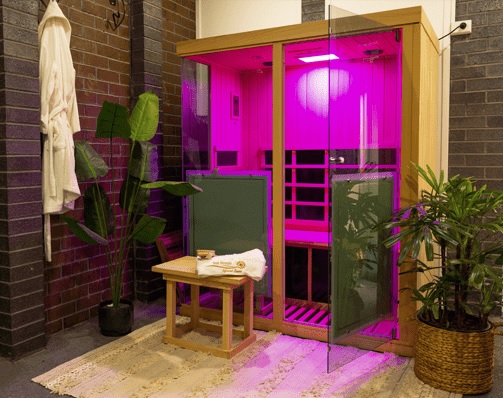Infrared vs Red Light Therapy: Understanding The Difference
When deciding between infrared vs red light therapy, it is important to understand the difference between them and the benefits they each provide, in order to come to a well-informed conclusion as to which will cater to your needs most.
Both types of therapies have been around for decades and are growing in popularity. Their similarities, such as the fact that they both use light for therapeutic purposes, means that they are often confused with one another, and with such an abundance of light therapies out there, it’s often difficult to decide which one to choose.
Read our expert guide, which compares the benefits of both infrared and red light therapy and how to effortlessly incorporate them into your life for a happier and healthier you.
What Is The Difference Between Infrared and Red Light Therapy?
Everyday, we are exposed to light energy that moves in waves and this is beneficial for our health. While we are only able to see these light waves if they range from 380 to 700 nanometers, our bodies can feel parts of the electromagnetic spectrum that are invisible to the eye, including infrared heat.
Both therapies use specific wavelengths of light, but they operate in different parts of the light spectrum leading to unique benefits and applications, so a red light bed or other treatment is not the same as an infrared sauna.
Red light waves range from 600 to 700 nanometers and are visible, while infrared light waves range from 700 to 1000 nanometers and are therefore invisible.

What Is Red Light Therapy?
Red light therapy works by using specific wavelengths of red light that penetrate the skin, stimulating the mitochondria in cells to increase the production of ATP (adenosine triphosphate), which stores and provides energy for cellular activities.
Red light therapy also enhances blood circulation, delivering oxygen and nutrients to skin cells, and these two actions combined promote beneficial processes such as improved healing and repair of tissues, reduced inflammation, and increased collagen production.
Red light therapy is generally considered less penetrative than infrared therapy and is therefore especially effective for addressing skin concerns such as fine lines, wrinkles, and overall texture and complexion.
Given that this treatment only reaches a depth less than 50mm into the skin, it is not typically recommended for conditions that require deeper tissue treatment, such as joint pain or muscle injuries, in which case, infrared treatments may be the better option.
Red light therapy can be applied in many ways, including handheld devices, LED panels, face masks, saunas or clinical treatment devices, giving you a range of options depending on your preferred experience.
Benefits of Red Light Therapy
Here are some of the main benefits associated with redlight therapy treatments:
Skin Rejuvenation
Red light therapy promotes cellular regeneration, leading to a more youthful and energised complexion.
Collagen Production
By regenerating fibroblasts and keratinocytes which are responsible for maintaining skin homeostasis, red light therapy enhances collagen production, improving skin elasticity and reducing wrinkles.
Reduced Inflammation
Red light therapy can decrease inflammation by improving blood flow, providing relief for various conditions.
Scar and Stretch Mark Reduction
Red light therapy can help fade scars and stretch marks by promoting skin regeneration.
Hair Growth Support
Red light therapy is believed to support hair growth and prevent hair loss by stimulating cellular processes in the skin, which helps regenerate fibroblasts, keratinocytes, and other skin tissues.
Mood Enhancement
Exposure to red light may boost serotonin levels, positively impacting mood and helping with symptoms of depression and anxiety.

What Is Infrared Therapy?
Infrared heat therapy is a more holistic treatment which works by using infrared wavelengths to generate heat within the body, raising the core temperature and promoting various therapeutic effects.
This treatment uses longer wavelengths of light than red light and penetrates the body by about 1.5 inches, allowing it to effectively reach nerves and muscle tissues. Although infrared light is classified as light energy, it is not visible to the human eye as it is positioned adjacent to red light on the electromagnetic spectrum, with wavelengths ranging from 800 nm to 1000 nm.
We therefore perceive it as warmth instead, and since all humans naturally produce infrared light, this therapy is safe, natural, and readily absorbed by our tissues.
Infrared light therapy enhances cellular energy absorption, which increases blood flow to the targeted area. This improved circulation aids in reducing inflammation, alleviating pain, and promoting healing, making infrared therapy a popular choice for individuals seeking relief from conditions such as arthritis, muscle soreness, and chronic back pain.
Infrared also acts as a natural detox as it breaks up fats and toxins that are trapped in water molecules when it enters the body and allows us to sweat them out naturally.
Benefits of Infrared Therapy
Here are some of the main benefits associated with infrared therapy:
Detoxification
Infrared therapy aids detoxification by promoting deep sweating, which helps eliminate toxins from the body. Regular use of an infrared sauna can support the body’s natural detox processes.
Reduced Inflammation
Infrared therapy can decrease inflammation by improving blood flow, providing relief for various conditions.
Improved Circulation
Infrared therapy enhances blood circulation by dilating blood vessels and increasing blood flow, which improves the delivery of nutrients and oxygen throughout the body. This can positively impact cardiovascular health and overall function.
Mood Enhancement
Exposure to red light may boost serotonin levels, positively impacting mood and helping with symptoms of depression and anxiety.
Pain Relief
Infrared saunas can help alleviate muscle soreness and joint discomfort. The heat from infrared waves relaxes muscles and reduces inflammation, providing relief from pain and stiffness, making it a popular choice for those with arthritis.
Accelerated Wound Healing
Red light therapy speeds up the healing process by increasing blood flow, and reducing inflammation.
How You Can Incorporate Both
Combining infrared heat therapy and red light therapy can provide a powerful, well-rounded approach to health and wellness. Infrared saunas offer detoxification and relaxation, which can enhance the skin benefits and pain relief effects of red light therapy.
Together, they create a comprehensive treatment strategy that addresses various health concerns.
For those seeking to combat signs of ageing or manage conditions like arthritis, using both therapies can yield even greater results.
The synergy of red and infrared light can effectively diminish wrinkles and improve skin complexion, while also soothing sore muscles and promoting regeneration.
You can access these therapies through infrared saunas, which are available at wellness centres and spas – or in the comfort of your own home with Sun Stream Saunas – offering a relaxing environment for detoxification.
Red light therapy devices are also accessible, ranging from at-home handheld units to larger panels. By integrating both therapies, you can maximise their potential benefits and enhance your overall well-being.
Final Considerations
When choosing between infrared therapy and red light therapy, your desired outcome is key. For surface-level skin conditions, red light therapy can be particularly effective, while infrared sessions are ideal for addressing deeper issues, such as high toxicity in the body, by facilitating toxin removal.
Infrared therapy offers a holistic approach to wellness, providing skin rejuvenation benefits similar to red light, along with additional advantages like calorie burning, pain relief, and deep relaxation, so this may be the better option if you’re not sure where to start.
Ultimately, the choice between an infrared sauna and red light therapy depends on your specific goals, but you don’t have to limit yourself to one—both can complement each other beautifully as part of a comprehensive health and wellness regimen.
If you want to find out more information about this topic, or you are interested in our range of home infrared saunas, make sure to contact us today.
